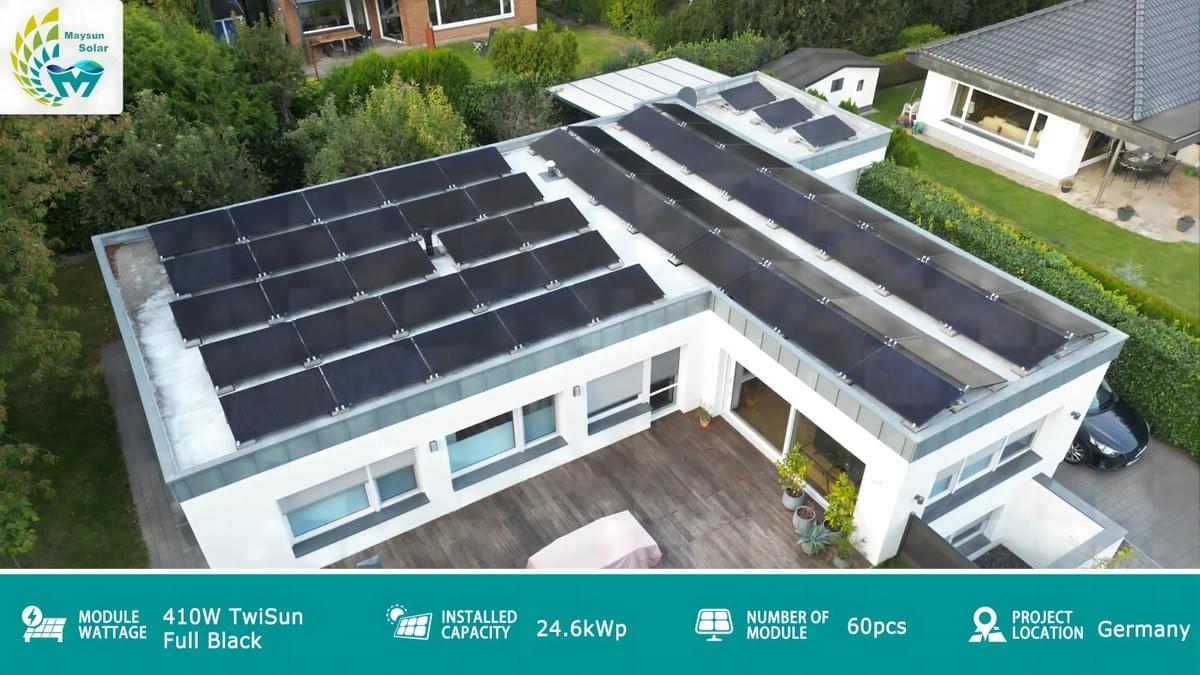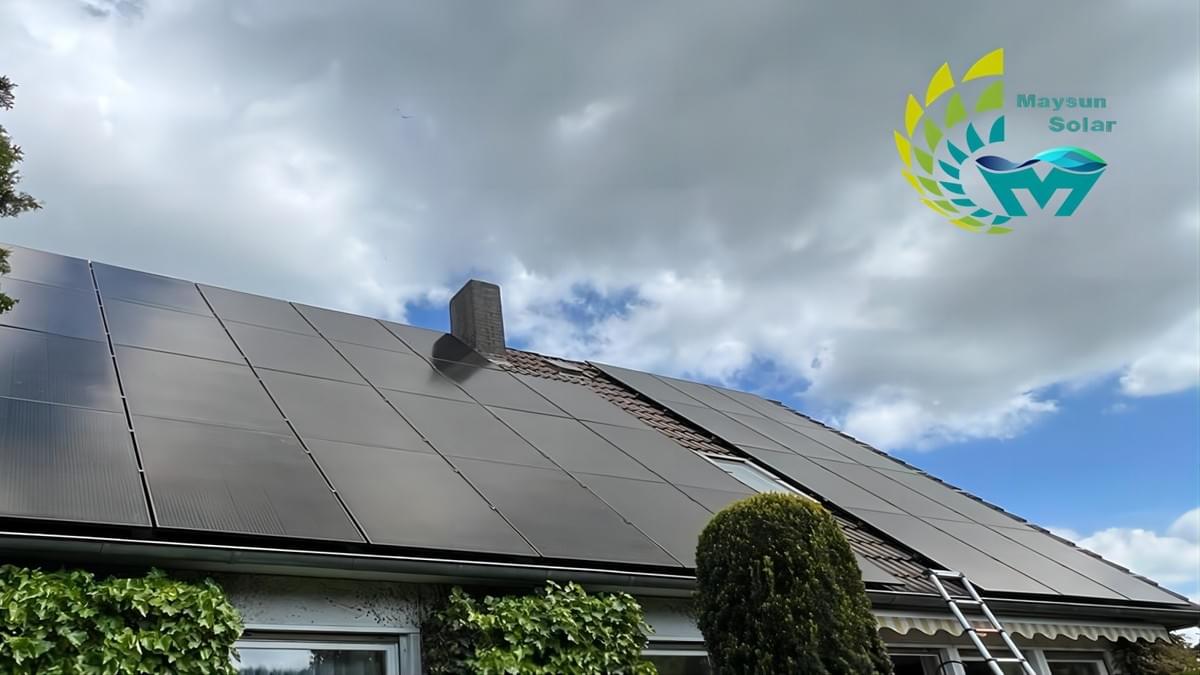Intro:
Many homeowners who want solar panels focus on getting the most cost-effective ones with high power ratings. While cost and power are crucial, how the panels look is also important. That's why many choose full black solar panels, especially if their neighbors can see any part of them. These panels give a polished and modern look. In this article, we'll explain how full black solar panels are made and discuss their pros and cons.
Contents:
- Why are Some Solar Panels Full Black?
- Advantages of Full Black Solar Panels
- Disdvantages of Full Black Solar Panels
- Are Full Black Solar Panels Worth Buying?
Why are Some Solar Panels Full Black?
The deep shade of full black solar panels comes from specific design and production methods aimed at reducing noticeable reflections and vibrant colors. Here's why:
Monocrystalline Cells: Polycrystalline silicon cells show mid-blue, monocrystalline silicon cells are dark blue, appearing almost black from a distance, so full black solar panels are usually selected monocrystalline cells, which makes the solar panels run more stably, and the overall appearance is more uniform and darker in colour.
Black Frame: To attain the desired full black aesthetic of solar panels, the frame is typically constructed using black anodized aluminium frame. This choice of black aluminum for the frame plays a significant role in creating the sleek and uniform all-black look of the solar panels.
Full Black Backsheet: The backsheet is the underside of the panel, and full black solar panels typically have a black backsheet. Backsheets for all-black solar panels are usually chosen from black materials such as black EVA (ethylene vinyl acetate copolymer) or other black backsheet materials. This helps to further reduce visible reflections.
Glass: The front glass of solar panels is generally maintained high light transmission as much as possible so that the cells can absorb more light and convert it into electricity. In the case of a glass-glass solar panel, it also has glass on the back. The back glass has two thicknesses, 2.0mm and 1.6mm, and is generally made of semi-tempered low-iron ultra-white photovoltaic glass with grid (black grid or white grid) or without grid according to the demand, which has incomparable advantages over the backsheet, and is gaining more and more recognition and share in the market. In glass-glass full black solar panels, the glass on the back (backglass) is usually transparent, which means that the sink bars and other connecting parts on the back may be visible in some cases. In order to maintain an overall full black appearance and to obscure these components, the manufacturer may add a black grid structure to the back glass. The purpose of this is to give the back of the solar panel a perfect black colour and to protect the busbar.
Encapsulation: Solar cells are encapsulated between the front glass and the back sheet with the help of ethylene-vinyl acetate (EVA) and a white Tedlar sheet for insulation. Full black solar panels usually use black Tedlar sheets or other alternative black encapsulation materials to maintain an aesthetically pleasing and consistent full black appearance.
Busbars and Contacts: In full black solar panels, the interconnecting wires or busbars between solar cells are also made from black materials or treated to appear black. This can be achieved by using black conductive adhesives or other black materials. Busbars and contacts on the front surface of the cells are designed to be black or dark in color to minimize visibility.
Silicone: Silicone is commonly used in the manufacturing of solar panels, especially glass-glass solar panels, to encapsulate and hold the solar cells in place, as well as to provide additional protection for the panels. In full black solar panel designs, the silicone is often dyed or selected to be black in order to maintain the overall black appearance. When attaching the solar panel’s frame to the glass, black silicone is employed to ensure the entire panel maintains a consistent and seamless color appearance. This use of black silicone not only enhances the panel’s overall aesthetics but also contributes to its cohesive, uniform look. The picture below shows what black silicone looks like on a full black solar panel.

In essence, full black solar panels get their deep black look by using black materials, cutting down reflections, utilizing high-efficiency cells, and fine-tuning the design. They're especially favored in areas where looks matter, like homes and architecture. But it's worth mentioning that sometimes their ability to convert energy might be a bit reduced to get that look.

Advantages of Full Black Solar Panels
Aesthetically Pleasing: Full black solar panels are designed to have a sleek and uniform appearance. They blend well with various roofing materials and surroundings, making them a preferred choice for those who are conscious of the visual impact of solar panels on their properties. These solar panels also contribute to the overall aesthetics of a building. Their all-black design is considered more visually appealing, which can improve the curb appeal of a home or commercial property.
Reduced Glare: Mounting systems are generally made of aluminium, which is attractive and highly reflective. The use of black mounting systems (including black solar panels, black mounting blocks, black brackets, etc.) can reduce these reflections. The full black design minimizes glare and reflection. This is particularly advantageous in narrow buildings, especially residential installations as it prevents neighbours from being disturbed or even blinded by the silver glare.
High Snow-Melting Capacity: Because of the heat-absorbing properties of the black aluminium material, snowy conditions can accelerate snow melting. Full black solar panels have a stronger heat-absorbing capacity, which allows them to melt snow faster in cold areas, thus increasing the efficiency of power generation.
Disdvantages of Full Black Solar Panels
Full black solar panels offer several advantages, as mentioned earlier, but they also have some disadvantages when compared to conventional solar panels (typically monocrystalline) and polycrystalline solar panels. Here are the main disadvantages of full black solar panels:
Lower Efficiency: While monocrystalline cells are known for their efficiency, full black solar panels may be slightly less efficient than traditional monocrystalline solar panels due to the added layer of black coating, which makes the full black solar panel heat up faster and operate at a higher temperature, with less opportunity to absorb reflected light, and therefore a slight reduction in overall efficiency. Tec Institute conducted a test in which full black solar panels warmed up by an average of 5 degrees on a sunny day. This resulted in a performance loss of approximately 2.3 %. However, this performance loss was hardly noticeable in private use. Full black solar panels may boast a more aesthetically pleasing appearance but forfeit the advantages of reflection and light trapping, resulting in a decrease in photocurrent, typically up to 3% less than a module with a white backsheet. A three percent reduction in current translates to approximately a 0.5% decrease in absolute efficiency. The black backsheet of full black solar panels absorb the sun’s rays, causing the PV module to encapsulate a CTM (Cell-to-Module) value that is about 2.5 % lower than that of a silver module, which also reduces the performance of the solar cells.
Higher Cost: Full black solar panels in the production of colour is more difficult to control, the choice of materials is extremely demanding, their glass to take a uniform batch of raw materials, the same production process of the same photovoltaic glass, and the need to choose a dark-coloured cell. To achieve the same colour and no colour difference is a big challenge for full black solar panels. The yield rate of full black solar panels is relatively low. Therefore, full black solar panels are often more expensive than conventional and polycrystalline solar panels. The black aesthetic design and the use of monocrystalline cells typically come at a premium.

Are Full Black Solar Panels Worth Buying?
Full black solar panels are gaining traction among consumers. They do have certain drawbacks: they cost more to produce, have fewer output yields, and suffer more power loss at high temperatures compared to their counterparts. Yet, the future seems promising for full black solar panels. Ongoing technological innovations are set to enhance their efficiency and adaptability for diverse uses.
Your choice should resonate with your specific requirements and preferences. If you prioritize aesthetics and are prepared to spend slightly more, full black solar panels might be right for you. On the other hand, if you're focused on getting the most value and performance for your money, traditional solar panels could be more suitable.
Check out the image below of the TwiSun glass-glass full black solar panels, fitted by a German professional in Maysun. Their sleek design seamlessly integrates with the rooftop. Tap on the photo for more product information!
Below you'll find a photo of the TwiSun 410W glass-glass full black solar panel set-up done by a different German professional. These panels blend seamlessly with the building's roof, providing consistent energy and looking great. Tap the photo or the button to learn more!
Since 2008, Maysun Solar has been dedicated to crafting top-tier photovoltaic modules. Our diverse range includes full black, black frame, silver, and glass-glass solar panels, all incorporating advanced technologies like half-cut, MBB, IBC, and Shingled. These panels deliver outstanding performance and possess sleek designs that harmonize with any structure. With offices and warehouses in various countries, and strong ties with proficient installers, Maysun Solar has made a significant mark. For up-to-date module pricing or any PV-related questions, reach out to us. We're eager to help.
You may read:





